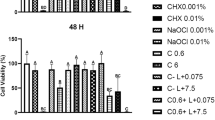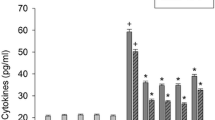Abstract
Chloramphenicol (CAP) is a broad-spectrum antibacterial drug that is widely used for topical application in ophthalmology and dermatology. In the present study we investigated the influence of CAP on human keratinocyte proliferation and apoptosis in vitro. CAP significantly inhibited proliferation and induced apoptosis of cultivated human keratinocytes, as revealed by incorporation of radioactive thymidine and flow cytometry analysis of intracellular esterase activity in fluorescein diacetate-stained cells, respectively. CAP-induced keratinocyte apoptosis was associated with activation of caspases and increased production of reactive oxygen species. The pro-apoptotic action of CAP was antagonized by the antioxidant agent N-acetylcysteine, the protein synthesis inhibitor cycloheximide, and PD98059, a selective inhibitor of extracellular signal-regulated kinase (ERK) activation. Taken together, these data indicate that CAP inhibits keratinocyte proliferation through induction of oxidative stress and ERK-mediated caspase-dependent apoptosis.
Similar content being viewed by others
Abbreviations
- CAP:
-
chloramphenicol
- CHX:
-
cycloheximide
- DHR:
-
dihydrorhodamine 123
- ERK:
-
extracellular signal-regulated kinase
- FDA:
-
fluorescein diacetate
- LDH:
-
lactate dehydrogenase
- NAC:
-
N-acetylcysteine
- ROS:
-
reactive oxygen species
- TB:
-
Trypan blue
References
Abou-Khalil S, Salem Z, Yunis AA. Mitochondrial metabolism in normal, myeloid, and erythroid hyperplastic rabbit bone marrow: effect of chloramphenicol. Am J Hematol. 1980;8:71–9.
Barzanti F, Zoli W, Susino MD, et al.. Simultaneous determination of apoptosis and surface antigen expression in tumor adherent cells. J Biol Regul Homeost Agents. 2001;15:359–65.
Bauer PM, Buga GM, Ignarro LJ. Role of p42/p44 mitogen-activated-protein kinase and p21waf1/cip1 in the regulation of vascular smooth muscle cell proliferation by nitric oxide. Proc Natl Acad Sci USA. 2001;98:12802–17.
Beltinger C, Fulda S, Kammertoens T, Uckert W, Debatin KM. Mitochondrial amplification of death signals determines thymidine kinase/ganciclovir-triggered activation of apoptosis. Cancer Res. 2000;60:3212–7.
Berry M, Gurung A, Easty DL. Toxicity of antibiotics and antifungals on cultured human corneal cells: effect of mixing, exposure and concentration. Eye. 1995;9:110–5.
Dameshek W. Chloramphenicol–-a new warning. JAMA. 1960;174: 1853–4.
Darzynkiewicz Z, Bruno S, Del Bino G, et~al. Features of apoptotic cells measured by flow cytometry. Cytometry. 1992;13:795–8.
Decker T, Lohmann-Matthes ML. A quick and simple method for the quantitation of lactate dehydrogenase release in measurements of cellular cytotoxicity and tumor necrosis factor (TNF) activity. J Immunol Methods. 1998;115:61–9.
Edinger AL, Thompson, CB. Death by design: apoptosis, necrosis and autophagy. Curr Opin Cell Biol. 2004;16:663–9.
Finkel T. Oxygen radicals and signaling. Curr Opin Cell Biol. 1998;10:248–53.
Fraunfelder FT, Bagby GC, Kelly DJ. Fatal aplastic anemia following topical administration of ophthalmic chloramphenicol. Am J Ophthalmol. 1982;93:356–60.
Gallenkemper G, Rabe E, Bauer R. Contact sensitization in chronic venous insufficiency: modern wound dressings. Contact Dermatitis. 1998;38:274–8.
Guimaraes CA, Linden R. Chloramphenicol induces apoptosis in the developing brain. Neuropharmacology. 2000;39:1673–9.
Guy RH, Hadgraft J, Maibach HI. Percutaneous absorption in man: a kinetic approach. Toxicol Appl Pharmacol. 1985;78:123–9.
Hockenbery DM, Oltvai ZN, Yin XM, Milliman CL, Korsmeyer SJ. Bcl-2 functions in an antioxidant pathway to prevent apoptosis. Cell. 1993;75:241–51.
Holt DE, Andrews CM, Payne JP, Williams TC, Turton JA. The myelotoxicity of chloramphenicol: in vitro and in vivo studies: II: In vivo myelotoxicity in the B6C3F1 mouse. Hum Exp Toxicol. 1998;17:8–17.
Isenberg SJ. The fall and rise of chloramphenicol. J AAPOS. 2003;7:307–8.
Ismail R, Teh LK, Choo EK. Chloramphenicol in children: dose, plasma levels and clinical effects. Ann Trop Paediatr. 1998;18: 123–8.
Jassim Al Khaja KA, Sequeira RR, Mathur VS. Trends in ophthalmic antimicrobial utilization pattern in Bahrain between 1993 and 2000: a resurgence of chloramphenicol. Int J Clin Pharmacol Ther. 2003;41:36–41.
Kamath S, Sinha S, Shaari E, Young D, Campbell AC. Role of topical antibiotics in hip surgery A prospective randomised study. Injury. 2005;36:783–7.
Kane DJ, Sarafian TA, Anton R, et~al. Bcl-2 inhibition of neural death: decreased generation of reactive oxygen species. Science. 1993;262:1274–7.
Karbowski M, Kurono C, Wozniak M, et~al. Cycloheximide and 4-OH-TEMPO suppress CAP-induced apoptosis in RL-34 cells via the suppression of the formation of megamitochondria. Biochim Biophys Acta. 1999a; 1449:25–40.
Karbowski M, Kurono C, Wozniak M, et~al. Free radical-induced megamitochondria formation and apoptosis. Free Radic Biol Med. 1999b; 26:396–409.
Kong CT, Holt DE, Ma SK, Lie AK, Chan LC. Effects of antioxidants and a caspase inhibitor on chloramphenicol-induced toxicity of human bone marrow and HL-60 cells. Hum Exp Toxicol. 2000;19:503–10.
Lam RF, Lai JS, Ng JS, Rao SK, Law RW, Lam DS. Topical chloramphenicol for eye infections. Hong Kong Med J. 2002;8:44–7.
Li CH, Tzeng SL, Cheng YW, Kang JJ. Chloramphenicol-induced mitochondrial stress increases p21 expression and prevents cell apoptosis through a p21-dependent pathway. J Biol Chem. 2005;280:26193–9.
Meves A, Stock SN, Beyerle A, Pittelkow MR, Peus D. Vitamin C derivative ascorbyl palmitate promotes ultraviolet-B-induced lipid peroxidation and cytotoxicity in keratinocytes. J Invest Dermatol. 2002;119:1103–8.
Peus D, Beyerle A, Vasa M, Pott M, Meves A, Pittelkow MR. Antipsoriatic drug anthralin induces EGF-receptor phosphorylation in keratinocytes: requirement for H$_{2}$O$_{2}$ generation. Exp Dermatol. 2004;13:78–85.
Ramachandran A, Moellering DR, Ceaser E, Shiva S, Xu J, Darley-Usmar V. Inhibition of mitochondrial protein synthesis results in increased endothelial cell susceptibility to nitric oxide-induced apoptosis. Proc Natl Acad Sci USA. 2002;99:6643–8.
Ratan RR, Murphy TH, Baraban JM. Macromolecular synthesis inhibitors prevent oxidative stress-induced apoptosis in embryonic cortical neurons by shunting cysteine from protein synthesis to glutathione. J Neurosci. 1994;14:4385–92.
Robbana-Barnat S, Decloitre F, Frayssinet C, Seigneurin JM, Toucas L, Lafarge-Frayssinet C. Use of human lymphoblastoid cells to detect the toxic effect of chloramphenicol and metabolites possibly involved in aplastic anemia in man. Drug Chem Toxicol.1997;20:239–53.{}
Roberts MS. Targeted drug delivery to the skin and deeper tissues: role of physiology, solute structure and disease. Clin Exp Pharmacol Physiol. 1997;24:874–9.
Stern GA, Schemmer GB, Farber RD, Gorovoy MS. Effect of topical antibiotic solutions on corneal epithelial wound healing. Arch Ophthalmol. 1983;101:644–7.
Trajkovic V, Vuckovic O, Stosic-Grujicic S, et~al. Astrocyte-induced regulatory T cells mitigate CNS autoimmunity. Glia. 2004;47:168–79.
Upadhyay MP, Karmacharya PC, Koirala S, et~al. The Bhaktapur eye study: ocular trauma and antibiotic prophylaxis for the prevention of corneal ulceration in Nepal. Br J Ophthalmol. 2001;85:388–92.
Yunis AA, Arimura GK, Isildar M. DNA damage induced by CAP and its nitroso derivative: damage in intact cells. Am J Hematol. 1987;24:77–84.
Author information
Authors and Affiliations
Corresponding author
Rights and permissions
About this article
Cite this article
Popadic, S., Popadic, D., Ramic, Z. et al. Chloramphenicol induces in vitro growth arrest and apoptosis of human keratinocytes. Cell Biol Toxicol 22, 371–379 (2006). https://doi.org/10.1007/s10565-006-0058-4
Received:
Accepted:
Published:
Issue Date:
DOI: https://doi.org/10.1007/s10565-006-0058-4




